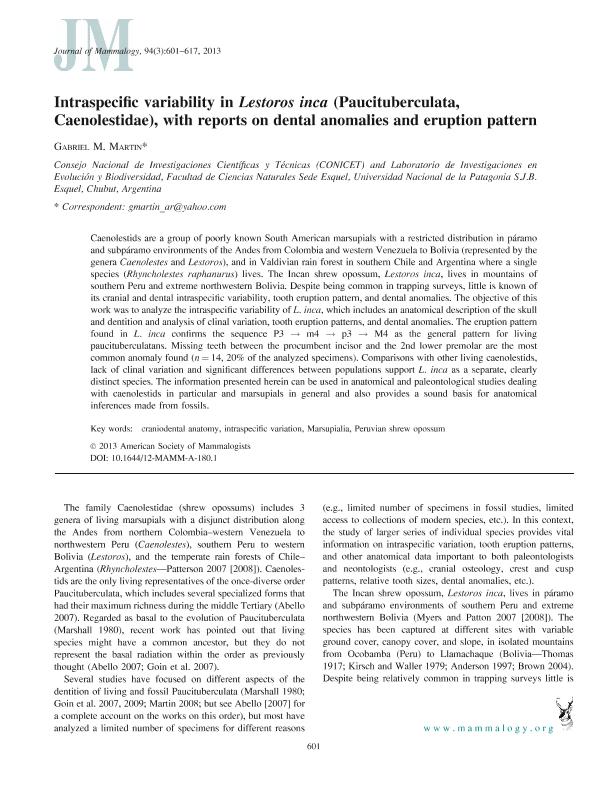Artículo
Intraspecific variability in Lestoros inca (Paucituberculata, Caenolestidae), with reports on dental anomalies and eruption pattern
Fecha de publicación:
06/2013
Editorial:
Alliance Communications Group Division Allen Press
Revista:
Journal of Mammalogy
ISSN:
0022-2372
Idioma:
Inglés
Tipo de recurso:
Artículo publicado
Clasificación temática:
Resumen
Caenolestids are a group of poorly known South American marsupials with a restricted distribution in páramo and subpáramo environments of the Andes from Colombia and western Venezuela to Bolivia (represented by the genera Caenolestes and Lestoros), and in Valdivian rain forest in southern Chile and Argentina where a single species (Rhyncholestes raphanurus) lives. The Incan shrew opossum, Lestoros inca, lives in mountains of southern Peru and extreme northwestern Bolivia. Despite being common in trapping surveys, little is known of its cranial and dental intraspecific variability, tooth eruption pattern, and dental anomalies. The objective of this work was to analyze the intraspecific variability of L. inca, which includes an anatomical description of the skull and dentition and analysis of clinal variation, tooth eruption patterns, and dental anomalies. The eruption pattern found in L. inca confirms the sequence P3 → m4 → p3 → M4 as the general pattern for living paucituberculatans. Missing teeth between the procumbent incisor and the 2nd lower premolar are the most common anomaly found (n = 14, 20% of the analyzed specimens). Comparisons with other living caenolestids, lack of clinal variation and significant differences between populations support L. inca as a separate, clearly distinct species. The information presented herein can be used in anatomical and paleontological studies dealing with caenolestids in particular and marsupials in general and also provides a sound basis for anatomical inferences made from fossils.
Archivos asociados
Licencia
Identificadores
Colecciones
Articulos(CCT-CENPAT)
Articulos de CTRO.CIENTIFICO TECNOL.CONICET - CENPAT
Articulos de CTRO.CIENTIFICO TECNOL.CONICET - CENPAT
Citación
Martin, Gabriel Mario; Intraspecific variability in Lestoros inca (Paucituberculata, Caenolestidae), with reports on dental anomalies and eruption pattern; Alliance Communications Group Division Allen Press; Journal of Mammalogy; 94; 3; 6-2013; 601-617
Compartir
Altmétricas




